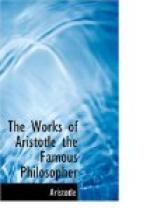When the woman is in this position, let the operator put up his or her hand, if the neck of the womb be dilated, and remove the coagulated blood that obstructs the passage of the birth; and by degrees make way gently, let him remove the infant tenderly, having first anointed his hand with butter or some harmless salve. And if the waters have not come down, they may then be let out without difficulty. Then, if the infant should attempt to come out head foremost, or crosswise, he should turn it gently, to find the feet. Having done this, let him draw out one and fasten it with ribbon and then put it up again, and by degrees find the other, bringing them as close together and as even as possible, and between whiles let the woman breathe, and she should be urged to strain so as to help nature in the birth, that it may be brought forth. And to do this more easily, and that the hold may be surer, wrap a linen cloth round the child’s thighs, taking care to bring it into the hand face downwards.
In case of flux of blood, if the neck of the womb be open, it must be considered whether the infant or the secundine, generally called the afterbirth, comes first, and as the latter happens to do so occasionally, it stops the mouth of the womb and hinders the birth, and endangers both the woman’s and the child’s life. In this case the afterbirth must be removed by a quick turn. They have deceived many people, who, feeling their softness, have supposed that the womb was not dilated, and by that means the woman and child, or at least the latter, have been lost. When the afterbirth has been removed, the child must be sought for and drawn out, as directed above; and if the woman or the child die in such a case, the midwife or the surgeon are blameless because they have used their best endeavours.
If it appears upon examination that the afterbirth comes first, let the woman be delivered as quickly as possible, because a great flow of blood will follow, for the veins are opened, and on this account two things have to be considered.
First:—The manner in which the afterbirth advances, whether it be much or little. If the former, and the head of the child appears first, it may be guided and directed towards the neck of the womb, as in the case of natural birth, but if there appears any difficulty in the delivery, the best way is to look for the feet, and draw it out by them; but if the latter, the afterbirth may be put back with a gentle hand, and the child taken out first. But if the afterbirth has come so far forward that it cannot be put back, and the child follows it closely, then the afterbirth must be removed very carefully, and as quickly as may be, and laid aside without cutting the entrail that is fastened to it; for you may be guided to the infant by it, which must be drawn out by the feet, whether it be alive or dead, as quickly as possible; though this is not to be done except in cases of great necessity, for in other cases the afterbirth ought to come last.




